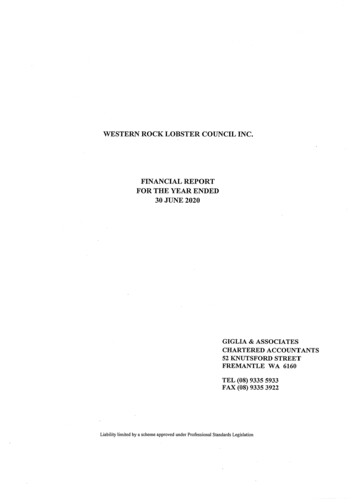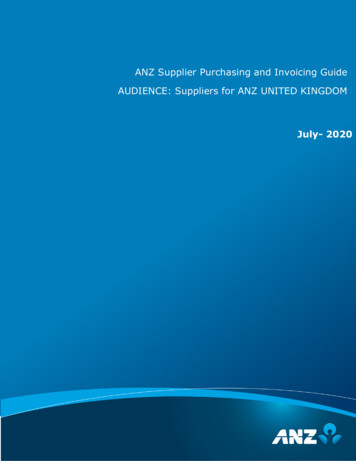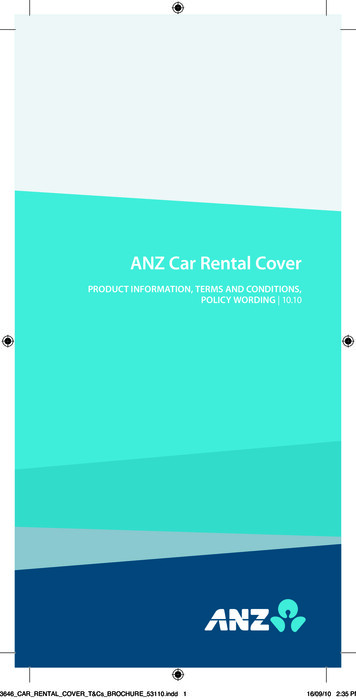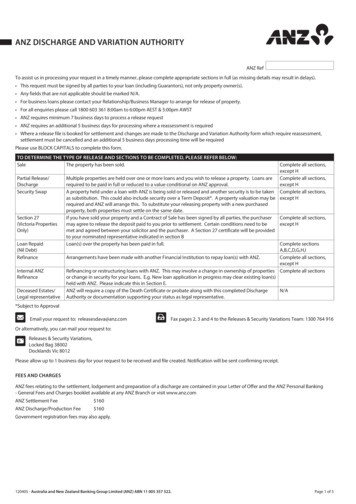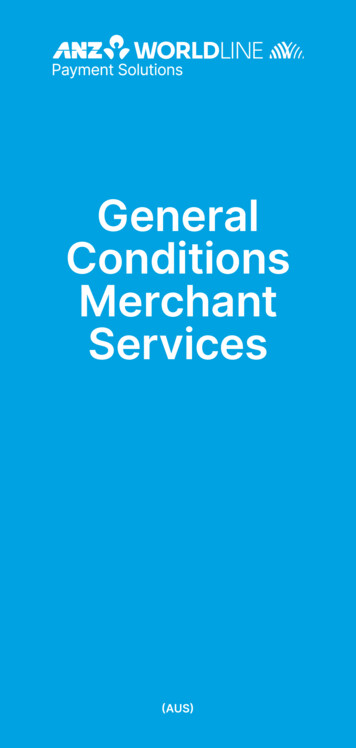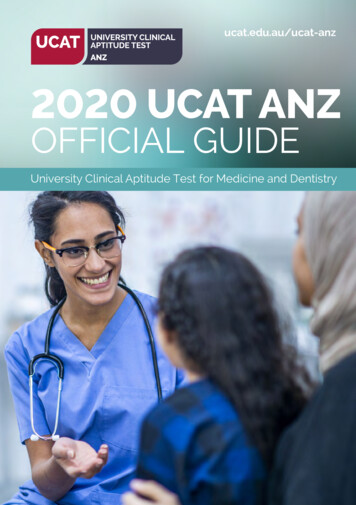
Transcription
ucat.edu.au/ucat-anz2020 UCAT ANZOFFICIAL GUIDEUniversity Clinical Aptitude Test for Medicine and DentistryUCAT ANZ Official Guide 2020 1
ForewordThis is the official guide to the UCAT ANZ 2020 which contains definitive informationregarding the test and its content. From 2019, the UCAT ANZ replaced the UMAT(Undergraduate Medicine and Health Sciences Admission Test) previously used by ourConsortium member universities.Sitting the UCAT ANZ is an important step in your application to medical or dental school. Werecommend you start your preparation by reading this guide as it is intended to give you acomplete overview of the steps involved in sitting the UCAT ANZ, including which universitiesrequire the test, key dates, how to register and book your test, what to expect on the day, andmost importantly how to prepare for the test. You will find detailed descriptions of each ofthe subtests, an explanation of the different question types, strategies, tips and advice fromprevious candidates, and over 130 practice questions and answers. We believe that thisguide, in conjunction with the free preparation materials and practice tests on our websiteucat.edu.au, are all you need to prepare successfully for the test.We do not endorse any commercial preparation courses for the UCAT and we would adviseyou to be sceptical about anyone’s claims to be able to help you do well in the test bycoaching. Of course you do need to practice in order to become familiar with test items andmost importantly the timing in each subtest. We give more advice in this guide regarding testpreparation and strategies.We hope you find this information useful. If you have any feedback and suggestions foradditional content please contact us.The UCAT ANZ ConsortiumThe UCAT ANZ Consortium is a group of Australian and New Zealand universitieswho use the UCAT ANZ as part of their selection process for medicine, dentistry andselected clinical sciences.We are committed to achieving greater fairness in selection and to the wideningparticipation of under-represented social groups in medical, dental and healthsciences training.The test is run by the Consortium in partnership with Pearson VUE, a global leader incomputer-based testing and part of Pearson plc. It is delivered on computers worldwidethrough Pearson VUE’s centres.Address details?ucat.edu.au2 UCAT 2013UCAT ANZ Official Guide 2020 2020 UCAT ANZ Consortium. All rights reserved
ContentsForeword2What is the UCAT?EligibilityKey dates 2020Who should take the test?Which Universities require the test?Where can I take the test?455667Registration and BookingRegistrationBookingTest FeesConcessionsRescheduling and Cancelling88991010Access ArrangementsAccess ArrangementsTest Accommodations111212Test FormatOverviewVerbal ReasoningDecision MakingQuantitative ReasoningAbstract ReasoningSituational JudgementMarking and ScoresUsing my Results131314151617182021Practising for the TestHow should I Prepare?Test Strategies and AdviceAdviser Resources22232426Test DayArrivalIdentificationPersonal belongingsEnvironmentCalculatorNote bookletBreaksProblemsUnprofessional behaviour27272828282829292929Mitigating CircumstancesIllness or Personal CircumstancesTest Day ProblemsCandidate Complaints30303131Practice QuestionsRationales and Answers3269Step-by-step guide84Preparation Plan86Feedback88UCAT ANZ Official Guide 2020 3
What is the UCAT?The University Clinical Aptitude Test (UCAT ANZ) is an admissions test used by a consortiumof universities in Australia and New Zealand for their medical , dental and selected clinicalscience degree programmes.The test helps universities to make more informed choices from amongst the manyhighly-qualified applicants to these highly competitive degree programmes. It assessesa range of abilities identified as important by university medical and dental schools forsuccess in their programmes or courses, and later as a clinician.The UCAT does not contain any curriculum or science content. It focuses onexploring the cognitive powers of candidates and other attributes considered tobe valuable for health care professionals.4UCAT ANZ Official Guide 2020
WHAT IS THE UCAT?EligibilityThe UCAT ANZ test is available toany candidate whose educationallevel at the time of sitting the testis their final year of secondaryschooling, or higher. Candidatesregistering for UCAT ANZ 2020should have already completed,or plan to COMPLETE their finalyear of secondary schooling in2020 (i.e. Year 12 in Australia; Year13 in New Zealand).Students whose currenteducational level is Australian Year11 or lower are NOT eligible to takeUCAT ANZ. This includes Year 11students undertaking one or moreYear 12 subjects. Year 12 studentscompleting Year 12 over two yearsare only eligible to sit UCAT ANZin their final year.Key dates 2020Concession Scheme opensAccess Arrangements open3 February 2020BOOKING OPENS2 March 2020Concession application deadlineAccess Arrangements deadline4 May 2020 at5pm AESTBOOKING DEADLINE11 May 2020 at11.59pm AESTLate booking deadline18 May 2020 at11.59pm AESTCancellation deadline18 May 2020 at11.59pm AESTTesting begins1 July 2020Last testing date31 July 2020Results delivered to universitiesby earlySeptember 2020UCAT ANZ Official Guide 2020 5
Who should take the test?The UCAT ANZ is a compulsory entry requirement for our Consortium Universities. You arerequired to sit the test by 31 July 2020 if you are intending to apply for entry in 2021 to arelevant course listed below. UCAT ANZ results cannot be carried over from one year to thenext. There are no general exemptions from the test.You may only take the test once in any test cycle and any instances of multiple testing in thesame year will be treated as an example of unprofessional behaviour.Which Universities require the test?Some pathways to medicine/dentistry/clinical sciences will not require the UCAT ANZ. For someapplicants a different test may be required. You should always check the entry requirementsfor each course or programme using the websites of the universities to which you intend toapply before booking a test as the information below may be subject to change. The UCAT ANZwebsite has the most up to date information.UniversityCourse or ProgrammeThe University of AdelaideMedicine, Dental Surgery, Oral HealthCharles Sturt UniversityDental ScienceCurtin UniversityMedicineFlinders UniversityClinical Sciences / MedicineLa Trobe UniversityDental ScienceMonash UniversityMedicineThe University of Newcastle /University of New EnglandJoint Medical ProgramThe University of New South WalesMedicineThe University of QueenslandMedicine (provisional entry), Dental ScienceUniversity of TasmaniaMedicineThe University of Western AustraliaMedicine (Direct Pathway),Dental Medicine (Direct Pathway)Western Sydney UniversityMedicineThe University of AucklandMedicineUniversity of OtagoMedicine, Dental Surgery6UCAT ANZ Official Guide 2020
WHAT IS THE UCAT?Where can I take the test?The UCAT ANZ is a compulsory entry requirement for our Consortium Universities in Australiaand New Zealand. The test is delivered in Pearson VUE test centres during July in thelocations listed below.AustraliaAvailable dates will be shown at the time of booking your test.CanberraArmidaleNewcastleOrangeParramattaPort MacquarieSydneyWagga WaggaAlice SpringsDarwinBrisbaneCairnsGold tonTownsvilleAdelaidePort ICVICWAWANew ZealandAvailable dates will be shown at the time of booking your tonNote: Most capital cities have multiple test centres. Details of the locations will be available toview when booking opens in March 2020.OverseasCandidates who will be overseas for the month of July 2020 should visit the Test CentreLocations page of our website for further information on where you can sit the test andhow to book an overseas test centre. Sitting the test overseas will incur an additionaladministrative fee.International CandidatesInternational applicants may not be required to sit the UCAT ANZ, an alternative admissiontest (ISAT) may be required. Candidates should check the course or programme entryrequirements on the websites of the relevant universities before booking a test.UCAT ANZ Official Guide 20207
Registration and BookingThe UCAT ANZ can be taken between 1 July and 31 July 2020. You must complete atwo-step process using the Pearson VUE online registration system to register andthen book a test.RegistrationYou must create an online account with Pearson VUE before you can book your test (we callthis first step registration). Follow the links on our website to create your Pearson VUE account:ucat.edu.au/registration and booking/You need to register for your test personally – this cannot be done by your school or college.8UCAT ANZ Official Guide 2020
REGISTRATION AND BOOKINGBookingTest FeesOnce you have registered you will be able tobook your test. Bookings open on 2 March2020 and close on 11 May 2020 at 11.59pmAEST (Australian Eastern Standard Time).The following test fees apply in 2020:Late bookings are accepted until 18 May2020 at 11.59pm AEST. All candidates mustbook a test by this date. An additional latefee applies for late bookings.We recommend booking your testappointment early in the booking window tomaximise the chance of attending aconvenient test centre.You should book a standard test unless youare eligible for extra time in public exams.Please see the Access Arrangements sectionof this guide for more information.You are strongly recommended to book atest date early in the July testing period. Eachyear there are candidates who book a latetest date and then encounter problems ifthey fall ill or experience other issues whichprevent them from taking that testappointment.Tests taken in Australia or NewZealand 299Concession Fee (Australia only) 199Tests taken overseas / outsideAustralia and New Zealand 374Late fee 75Test fees depend on the test centrelocation, not on your place of residenceor nationality.Candidates in Australia can also refer to ourConcession Scheme overleaf, to see whetherthey are eligible to pay a reduced test fee.The test fee is payable online at the timeof booking. All fees will be charged inAustralian dollars.The additional late fee applies to allbookings completed after 11.59pm AEST on11 May 2020 and before 11.59pm AEST on18 May 2020.UCAT ANZ Official Guide 20209
ConcessionsRescheduling and CancellingCandidates who hold (or who are listed as adependant on) a current Australian HealthCard Card (HCC) or Pensioner ConcessionCard (PCC), both of which are issued byCentrelink, are eligible for a reduced testfee. The concession fee is not available tocandidates sitting the test outside Australia.If you are not fit to take your test due toillness or other personal circumstances youmust reschedule your test to a later dateeven if this means losing the test fee.You will need to submit the online applicationform and upload a copy of your concessioncard before you make your test booking tobe eligible for this reduced fee.Applications without the correct supportingevidence or late applications received afterthe deadline of 5pm AEST on 4 May 2020will not be considered.Further information regarding applyingfor a concession can be found hereucat.edu.au/ucat-anz/concession-scheme/You may reschedule your test online throughyour Pearson VUE account until 18 Mayat 11.59pm AEST. After this date you mustphone Pearson VUE Customer Servicesto reschedule your test. Please note thatrescheduling is based on availability.Convenient dates and times will be limited inthe last two weeks of testing.Rescheduling must be done a full 24 hoursbefore your test. If you miss this deadlineyou will need to pay the test fee again toreschedule your test appointment (subjectto availability). You still need to give theappropriate amount of notice even thoughthe Pearson VUE Customer Serviceshelpline is only available Monday to Fridayfrom 09:00 to 18:00 (local time).You can cancel your test through yourPearson VUE account up to the cancellationdeadline of 11.59pm AEST on 18 May 2020to receive a refund. If you have to cancellater than this, the appointment will countas a 'no-show' and payment will not berefunded.Please see the Rescheduling andCancelling page of the UCAT ANZwebsite for full details : ling-and-cancelling/10UCAT ANZ Official Guide 2020
Access ArrangementsIf you have a Specific Learning Difficulty such as dyslexia, a disability, medical conditionor temporary injury you may be entitled to Access Arrangements such as extra time, restbreaks or accommodations.Applications for Access Arrangements can be made from 2 February until the deadlineof 5pm AEST on 4 May 2020.Access Arrangements applications must be accompanied by suitable officialdocumentation from an educational psychologist or registered health practitioner.UCAT ANZ Official Guide 202011
Access Arrangements If you are entitled to any of the following accessarrangements you must apply to the UCATANZ Office for approval before you can bookyour test: UCATSA - 5 minute rest breaks betweensectionsUCATSEN - 25% extra timeUCATSENSA - 25% extra time with 5minute rest breaks between sectionsSeparate room (subject to availability)Access to medical items or medicallynecessary food/drink. This arrangementrequires a separate room, which issubject to test centre availability.You should apply by completing the AccessArrangements application form on the websiteand submitting the correct supportingevidence (outlined below) by 5pm AEST on4 May 2020. You will be notified of theoutcome by email within 5 business days andmust then phone Pearson VUE CustomerServices to book your test.When you submit your application forAccess Arrangements you must also submitsupporting documentation. The followingrequirements apply: Your documentation must be from aregistered health practitioner on thepractitioner's official letterhead includingthe date and title, name, registrationnumber, contact details, and signature ofthe practitioner.For disabilities or health related needs,other than learning disabilities, yourdocumentation must be no more than oneyear old.For learning disabilities, a copy of anappropriate educational psychologist'sreport (no more than 3 year's old) will beacceptable. A report older than 3 yearswill be acceptable if it is accompaniedby a recent letter from an educationalpsychologist stating that the information inthe report is still applicable.Your documentation: Must give a clear diagnosis and informationon the condition, indicate the impact ofthe condition in test settings and includea statement as to what adjustments thepractitioner considers appropriate for thecandidate in test settings.Note the UCAT is a multiple-choice, online testand does not require extended handwriting.AccommodationsIf you require accomodations when sitting thetest you should email the UCAT ANZ Office forapproval before you make your test booking(you do not need to provide supportingevidence for the following): Wheelchair access*Adjustable height desk*Changes to the test colour scheme and/or font size)Coloured overlays (provided by thecandidate)* subject to test centre availabilitySome medicines, medical devices, mobilitydevices and other items are consideredComfort Aids. They are allowed into the testroom after visual inspection and do not requireany arrangements. A full list is available on theAccess Arrangements page of our website.For further information on how to apply foraccess arrangements, including acceptablesupporting evidence, please ensure you readthis section of our website carefully: ucat.edu.au/uca-anz/access-arrangements/12UCAT ANZ Official Guide 2020
Test FormatOverviewThe UCAT assesses a range of abilities identified by university Medical and Dental Schoolsas important. There is no curriculum content as the test examines innate skills. Eachsubtest is in a multiple-choice format and is separately timed.For candidates sitting the UCAT in 2020, the test will consist of: Verbal reasoning - assesses ability to critically evaluate information that is presented in awritten form Decision making - assesses ability to apply logic to reach a decision or conclusion,evaluate arguments and analyse statistical information Quantitative reasoning - assesses ability to critically evaluate information presentedin a numerical form Abstract reasoning - assesses the use of convergent and divergent thinking to inferrelationships from information Situational judgement - measures capacity to understand real world situations and toidentify critical factors and appropriate behaviour in dealing with them.UCAT - Standard Test(120 minutes)SEN - Extended Test(150 minutes)Time (includinginstructions)QuestionsVerbal Reasoning22 minutes44 questionsDecision Making32 minutesQuantitativeReasoningTime (includinginstructions)QuestionsVerbal Reasoning27 minutes30 seconds44 questions29 questionsDecision Making40 minutes29 questions25 minutes36 questionsQuantitativeReasoning31 minutes15 seconds36 questionsAbstractReasoning14 minutes55 questionsAbstractReasoning17 minutes30 seconds55 questionsSituationalJudgement27 minutes69 questionsSituationalJudgement33 minutes45 seconds69 questionsSectionSectionUCAT ANZ Official Guide 202013
Verbal ReasoningThe Verbal Reasoning subtest assessesyour ability to read and think carefully aboutinformation presented in passages and todetermine whether specific conclusions canbe drawn from information presented. Youare not expected to use prior knowledge toanswer the questions.UCAT TimeQuestions22 minutes(one minute forinstruction and21 minutes forquestions)44 questions associatedwith 11 readingpassagesWhy Verbal Reasoning?Doctors and dentists need excellent verbalreasoning skills in many aspects of theirwork. An ability to understand complexinformation and communicate this clearlyand simply to patients is obviously essential.Medical practitioners must also be able tointerpret findings from published materialsand apply this to their own practice. It isalso essential they are able to critique suchmaterials and draw their own conclusion asto the validity of any findings.Verbal Reasoning ItemsYou will be presented with eleven passagesof text, each associated with four questions.Some questions assess critical reasoningskills, requiring candidates to make inferencesand draw conclusions from information. Youwill need to read the passage of text carefully.You will then be presented with questionswhich comprise a stem, which might be anincomplete statement or a question, with fourresponse options.The candidate is required to pick the best ormost suitable response. Candidates will onlybe able to select one response.14UCAT ANZ Official Guide 2020For other test questions, your task is to readeach passage of text carefully and thendecide whether the statement providedfollows logically from the information in thepassage. In each case you can choose True,False or Can’t Tell.Verbal Reasoning Strategies You are unlikely to be familiar with thecontent of the text shown to you. Do notdraw on existing knowledge as this willnot be relevant. Think about how you will plan your time inthis section. Work on your speed reading skills duringyour preparation by reading articles in thenewspapers and learning to extract thekey facts quickly. This section requires real concentration– it is at the beginning of the test and youshould be ready to focus right from the start.The best thing to prepare forVerbal Reasoning is to read anewspaper or even non-fictionbooks daily, examining thearguments, logical fallacies andtechniques used. Join debategroups, and read around logicalfallacies and formal logic aswell. Learn to unpick argumentsand read quickly. If you readfor 15 minutes every day, you’llgradually become better, andthis section will seem very easyby the time you have to takethe UCAT.”Jonathan, 99th percentile
TEST FORMATDecision MakingThe Decision Making subtest assesses yourability to apply logic to reach a decision orconclusion, evaluate arguments and analysestatistical information.Decision Making Strategies Timing is important in this subtest. Flagquestions you are unsure about so youcan come back to them at the end. It may help you to write out or draw theinformation given in the question. Makesure you have your note board and pento hand. Some questions require you to 'drag anddrop' the correct response. Practice thisfunctionality in the Tour Tutorial.Why Decision Making? Doctors and dentists are often required tomake decisions in situations that may becomplex. This requires high-level problemsolving skills and the ability to assess andmanage risk and deal with uncertainty.Brush up on your maths skills aroundprobability and Venn diagrams. Some items ask you to weigh argumentsfor and against a particular solution to aproblem. You must suspend your ownbeliefs to reach the strongest conclusion. There are a number of different questiontypes; if there are some you find morechallenging, flag these for review andanswer the item types you find easier first.UCAT Time32 minutes(one minute forinstruction and31 minutes forquestions)Questions29 questions associatedwith diagrams, text, chartsor graphsDecision Making ItemsYou will be presented with questions thatmay refer to text, charts, tables, graphs ordiagrams. Additional information may bepresented within the question itself.All questions are standalone and do notshare data. Some questions will have fouranswer options but only one correct answer;others will require you to respond to fivestatements by placing a 'yes' or 'no' answernext to each statement.A simple on-screen calculator is available foruse in this section. You may also need to useyour note board and pen.For Decision Making, which hasa wide variety of question types,I identified which types I wasbest at and did them first whendoing papers. I would aim toget them right before goingonto more time consumingquestions”Shivani, 99th percentileUCAT ANZ Official Guide 202015
Quantitative ReasoningThe Quantitative Reasoning subtestassesses your ability to use numerical skillsto solve problems. It assumes familiaritywith numbers. However, items are less todo with numerical facility and more to dowith problem solving (i.e. knowing whatinformation to use and how to manipulateit using simple calculations and ratios). Thesubtest measures reasoning using numbersas a vehicle rather than measuring a facilitywith numbers.UCAT TimeQuestions25 minutes (oneminute for instructionand 24 minutes forquestions)36 questionsassociated with tables,charts, and/or graphsA simple on-screen calculator is availablefor use in this section. The calculator isintegrated into the practice tests and westrongly recommend that you familiariseyourself with using it. You can also utilizeyour note board and pen.Quantitative Reasoning Strategies Timing is very important in this section –pace yourself during the test. Check howyou are doing halfway through and adjustyour speed accordingly. Read the questions carefully – individualwords and units may be crucial inanswering the question correctly. In the first place try to understand thescenario presented – this will help youfocus quickly on the questions. Use the laminated note board and penprovided to assist with your calculations. Review where there might be gapsin your maths. You may need to workout percentages, averages, ratios andfractions – remind yourself how to dosome of these calculations if they arecausing you problems. If you are finding a question difficult,eliminate the more obvious incorrectanswers and make an educated guess. Practice your mental arithmetic to speedup your answering by reducing yourreliance on the calculator.Why Quantitative Reasoning?Doctors and dentists are constantly requiredto look at data, review it and apply it to theirown practice. On a practical level drugcalculations based on patient weight, ageand other factors have to be correct. At amore advanced level, medical and dentalresearch requires an ability to interpret,critique and apply results presented inthe form of complex statistics. Universitiesconsidering applicants need to know theyhave the aptitude to cope in these situations.Quantitative Reasoning ItemsYou are required to solve problems byextracting relevant information from tablesand other numerical presentations. Mostquestions will be shown as a set of fourquestions each connected to the same data.There are some questions that standaloneand do not share data. Each question has fiveoptions. Your task is to choose the best option.16UCAT ANZ Official Guide 2020
TEST FORMATAbstract ReasoningAbstract Reasoning assesses your ability toidentify patterns amongst abstract shapeswhere irrelevant and distracting materialmay lead to incorrect conclusions. The testtherefore measures your ability to changetrack, critically evaluate and generatehypotheses and requires you to queryjudgements as you go along.UCAT TimeQuestions14 minutes (oneminute for instruction,13 minutes forquestions)55 questionsassociated with setsof shapesWhy Abstract Reasoning?When considering possible diagnoses,medical practitioners may be presentedwith a set of symptoms and/or results.Some information may be more reliable,more relevant and clearer than otherinformation. Doctors and Dentists need tomake judgements about such information,identifying the information which will helpthem reach conclusions. Carrying outresearch involving data often involvesidentifying patterns in results in order togenerate further hypotheses.For type 2, you will be presented with aseries of shapes. You will be asked to selectthe next shape in the series.For type 3, you will be presented with astatement, involving a group of shapes. Youwill be asked to determine which shapecompletes the statement.For type 4, you will be presented with twosets of shapes labelled “Set A” and “Set B”.You will be asked to select which of the fourresponse options belongs to Set A or Set B.Abstract Reasoning Strategies Timing is again very challenging in thissection. Remember to leave time to review set Aand set B at the beginning of each set ofquestions. Once you have identified whatlinks each set you are half way there. Consider patterns around size and shapeof objects; number of objects; sides ofobjects; shading and colour; symmetry,number of angles, position and direction.this sounds complicated but as you lookat these shapes you will start to graspwhat you need to focus on. What links shapes in set A and those inset B will often be linked in some way –remembering this may help you ignoredistracting information. If you can’t see the pattern, don’t wastetime; flag this set of questions and moveon to the next set of shapes. You canrevisit it if you have time at the end.Abstract Reasoning ItemsThere are 4 different question types in theAbstract Reasoning subtest.For type 1, you will be presented with twosets of shapes labelled “Set A” and “Set B”.You will be given a test shape and asked todecide whether the test shape belongs toSet A, Set B, or Neither.UCAT ANZ Official Guide 2020 17
Situational JudgementThe test measures your capacity tounderstand real world situations and toidentify critical factors and appropriatebehaviour in dealing with them.UCAT TimeQuestions27 minutes (oneminute for instructionand 26 minutes forquestions)69 questionsassociated with 22scenarios (consistingof between 2 and 5questions)Why Situational Judgement?The test assesses integrity, perspectivetaking, team involvement, resilience andadaptability. SJTs are used widely in medicaland dental selection, including selection ofInterns, GPs and other medical specialities.Situational Judgement Test ItemsThe test consists of a series of scenariosfor which you will need to consider eitherthe appropriateness of possible actions, orthe importance of possible considerations.You do not require medical or proceduralknowledge to answer.Some of the questions require you to rateeach response from four possible options.When considering how to respond to theimportance of certain options, an option is: Very important if this is something that isvital to take into account Important if this is something thatis important but not vital to take intoaccount Of minor importance if this is somethingthat could be taken into account, but itdoes not matter if it is considered or not18UCAT ANZ Official Guide 2020 Not important at all if this is somethingthat should definitely not be taken intoaccount.When considering how to respond to theappropriateness of certain options, anoption is: A very appropriate thing to do if itwill address at least one aspect (notnecessarily all aspects) of the situation Appropriate, but not ideal if it could bedone, but is not necessarily a very goodthing to do Inappropriate, but not awful if it shouldnot really be done, but would not beterrible A very inappropriate thing to do if itshould definitely not be done and wouldmake the situation worse.Other questions require you to choose themost and least appropriate action to takefrom the three options provided.For SJT look at lots of pastquestions, and read through theexplanations or model answersthat are given as feedback.A general summary of anyappropriate answer wouldbe that the idea proposed isa local, direct solution to theproblem, that doesn’t reflectbadly upon the profession andalways puts the patient first.”Emma, 99th percentile
TEST FORMATSituational Judgement Strategies Read each scenario and responsethoroughly before answering. Remember, there are different stylesof questions in this subtest; read theinstructions carefully to make sure youunderstand what you have to do. Within a scenario, each rating can beused more than once or not at all. Forexample, all response options
This is the official guide to the UCAT ANZ 2020 which contains definitive information regarding the test and its content. From 2019, the UCAT ANZ replaced the UMAT . guide, in conjunction with the free preparation materials and practice tests on our website ucat.edu.au, are all you need to prepare successfully for the test. .




